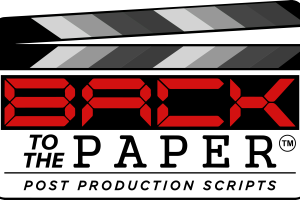Have you ever wondered where the average $100 million budget for Hollywood movies goes? Every film has a lot of working parts and involves a lot more talent than the actors who appear on-screen and the director sitting behind the camera. A Combined Continuity and Spotting List (CCSL) is one of the vital secrets of TV and film production. Don’t worry if you’re new to CCSL terminology.
We’ve broken it down below, so keep reading.
What Is a Combined Continuity and Spotting List?
A CCSL is an accompanying tool to a film script, used to ensure consistency and accuracy in editing in the post-production process. It’s one of many post-production scripts like dialog lists and as-broadcast scripts.
It does so by combining two elements: continuity and spotting.
Importance of a CCSL in Film Distribution and Post-Production
The significance of a CCSL in film distribution and post-production can’t be overstated.
It’s a standardized document that enables smooth post-production processes by including every relevant detail for editing and translation purposes. That makes a CCSL particularly important for international distribution.
Language barriers aren’t the only hurdles for subtitling, dubbing, and translation. Cultural differences pose significant challenges, which can lead to the subtext of a line of dialogue or significance or a scene getting lost.
The main benefit of a CCSL is that it ensures consistency across all aspects of production. For example, all translators and voice actors will be working from the same script that details not only the dialog but also the meaning behind it.
A CCSL can also save time during the post-production process. With all relevant information at their fingertips, post-production editors can focus on their tasks without having to constantly review the original scenes.
Finally, an often overlooked benefit of a CCSL is its role in preserving the film for future generations. This comprehensive record of a film’s content helps future filmmakers access and study its contents easily.
Key Components of a CCSL Script Service
A CCSL script service creates the Combined Continuity and Spotting List for a film. To ensure the CCSL is accurate, the scrip service must include these things:
- Scene and shot descriptions
- Dialogue
- Visual and audio cues
- Timecodes
Keep reading for a breakdown of the CCSL terminology.
Common CCSL Terminology
Broadly speaking, CCSL terminology falls into three categories:
- Continuity refers to maintaining consistency in various aspects of the film
- Spotting involves identifying specific points in the film where new elements (sound effects, music, etc) are added
- The Combined Continuity and Spotting List contains both continuity and spotting information and serves as a reference for editors, sound designers, and post-production teams
Continuity
What’s there to know? Continuity refers to what’s going on on-screen, so we’ll address these terms:
- Shot
- Scene
- Action
- Dialogue
- Props
- Wardrobe
- Makeup
- Set dressing
A shot is a single, uninterrupted sequence of frames captured by the camera. Across the film industry, the Average Shot Length (ASL) varies by genre and date. ASLs have declined steadily since the 1930s from over 12 seconds to under 3.
A scene is a collection of shots that are meant to be taken together. Usually, a scene takes place in a specific location or time.
Action describes any physical movement or activity performed by actors within a shot or scene. This could be as simple as sitting down at a table or as complicated as fixing a set of broken electronics.
Dialogue is often the meat of the scene. It refers to the spoken lines between characters.
Objects and items used to enhance storytelling are props, while the clothing and costumes they wear are described by the wardrobe.
Makeup refers to the application of cosmetics and hairstyling to achieve a desired portrayal of a character.
Finally, the set dressing describes the arrangement and decoration of physical elements of a scene.
Spotting
If continuity refers to on-screen events, spotting is what happens out of frame. The most important terms are:
- Cue
- Sound effects (SFX)
- Foley
- Music
- Dialog spotting
- Sound mixing
A cue is a specific point in a film that requires a new audio element, such as music, a sound effect, or a line of dialogue. Sound effects are artificial or enhanced sounds that are usually recorded separately from the on-set sound.
They can be used to enhance a scene and often help to fix a viewer’s attention on a particular element. For example, the sudden ringing of a telephone can draw a viewer’s eye to a nondescript phone booth at the edge of a shot.
A foley is a reproduction of everyday sound effects. Footsteps, the rustling of clothes, and objects interacting all enhance the auditory experience. Similarly, music often complements the emotional tone of a scene, and composed and selected background scores are cued in post-production.
Dialog spotting identifies specific lines or moments where dialogue needs to be enhanced or adjusted for clarity or impact.
Finally, sound mixing refers to the process of balancing various audio elements to create an immersive experience.
CCSL
The CCSL is the combination of continuity and spotting into one convenient document, and can include additional terms and annotations:
- Shot and scene numbers
- Descriptions
- Timecodes
- Subtitle time code in/out
- Continuity notes
- Spotting notes
- Dialog annotation
The shot and scene numbers are unique IDs assigned to each shot or scene. This is almost always done in numerically ascending order, beginning with a shot or scene “1”.
Detailed descriptions of visual elements, actions, dialogue, and audio cues often accompany each shot. This is to let everybody know what is happening, the background behind it, and any relevant subtext or clarification that may be needed by annotation and translation teams.
Timecodes indicate the exact start, end, and duration of a particular element within a shot or scene. Subtitle in and out timecodes dictate when a line of dialog needs to be displayed on-screen.
Continuity and spotting notes are additional observations and remarks related to visual continuity and adding or adjusting audio elements. For instance, a continuity note might clarify actor positions and set dressing.
Finally, dialog annotations add clarity to lines of dialog. They’re particularly important for subtitling and translation teams. Annotations clarify idioms, ambiguous phrases, subtext, and background information to remove ambiguity for post-production teams.
Efficient and Fairly Priced CCSL
In a globalized film industry, the importance of CCSLs is as high as ever. It’s crucial for filmmakers to stay up-to-date with CCSL terminology to navigate the ever-changing landscape of the film industry and its post-production processes.
Back To The Paper offers a variety of CCSL and CDSL services, tailored to meet the needs of different budgets. From cost-effective and simple to comprehensive and fully annotated CCSL, our pricing options are flexible. You can click here to learn more.


